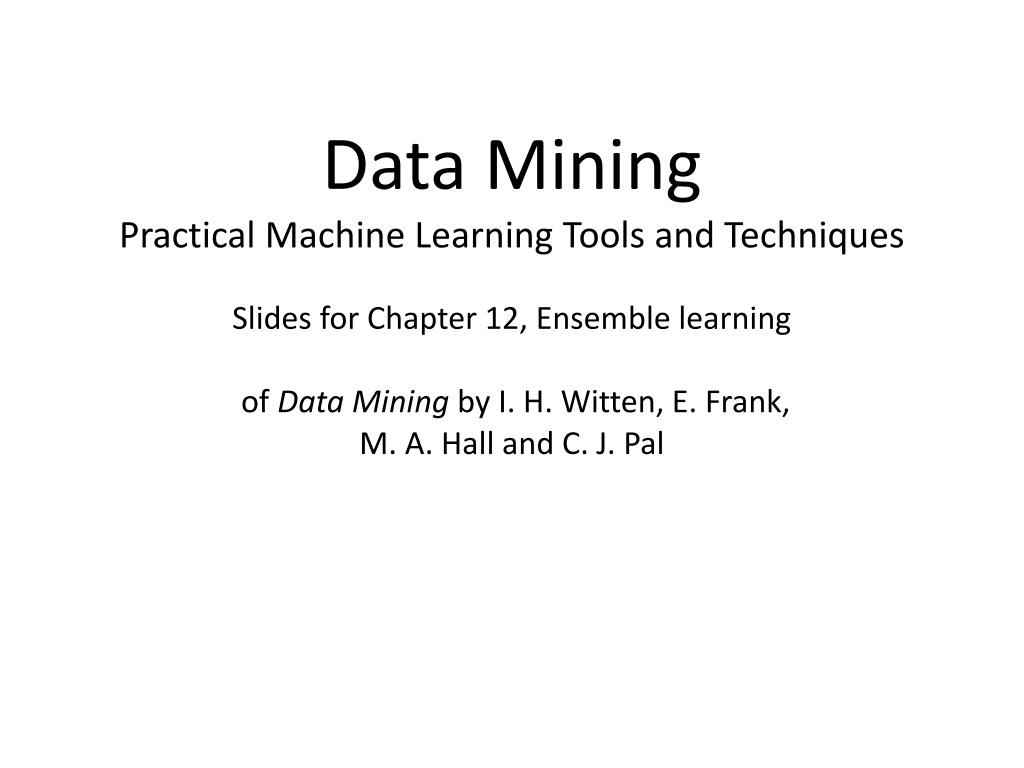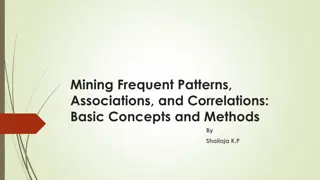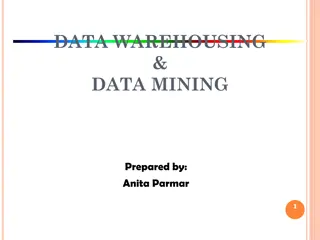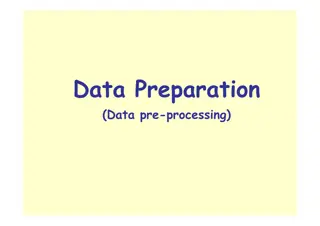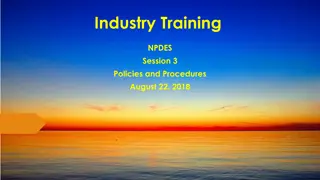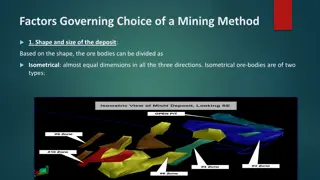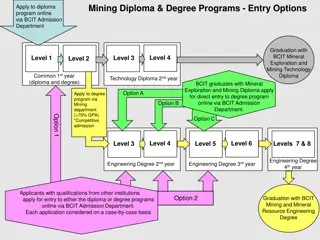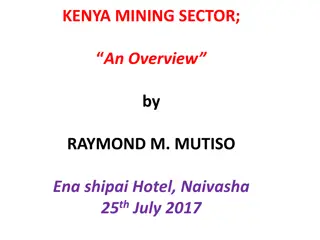Data Mining
Ensemble learning in data mining involves combining multiple models to improve predictive performance. Techniques such as bagging and boosting are utilized to create a single comprehensive structure from diverse experts. Bias-variance decomposition is used to analyze the impact of training set restrictions on performance. The process of combining predictions by voting or averaging enhances model stability and accuracy. Explore the advantages and disadvantages of ensemble learning approaches and understand how different experts can collaborate to enhance model performance.
Download Presentation

Please find below an Image/Link to download the presentation.
The content on the website is provided AS IS for your information and personal use only. It may not be sold, licensed, or shared on other websites without obtaining consent from the author.If you encounter any issues during the download, it is possible that the publisher has removed the file from their server.
You are allowed to download the files provided on this website for personal or commercial use, subject to the condition that they are used lawfully. All files are the property of their respective owners.
The content on the website is provided AS IS for your information and personal use only. It may not be sold, licensed, or shared on other websites without obtaining consent from the author.
E N D
Presentation Transcript
Data Mining Practical Machine Learning Tools and Techniques Slides for Chapter 12, Ensemble learning of Data Mining by I. H. Witten, E. Frank, M. A. Hall and C. J. Pal
Ensemble learning Combining multiple models The basic idea Bagging Bias-variance decomposition, bagging with costs Randomization Random forests, rotation forests Boosting AdaBoost, the power of boosting Additive regression Numeric prediction, additive logistic regression Interpretable ensembles Option trees, alternating decision trees, logistic model trees Stacking 2
Combining multiple models Basic idea: build different experts , let them vote Advantage: often improves predictive performance Disadvantage: usually produces output that is very hard to analyze but: there are approaches that aim to produce a single comprehensible structure 3
Bagging Combining predictions by voting/averaging Each model receives equal weight Idealized version: Sample several training sets of size n (instead of just having one training set of size n) Build a classifier for each training set Combine the classifiers predictions Learning scheme is unstable almost always improves performance Unstable learner: small change in training data can make big change in model (e.g., when learning decision trees) 4
Bias-variance decomposition The bias-variance decomposition is used to analyze how much restriction to a single training set affects performance Assume we have the idealized ensemble classifier discussed on the previous slide We can decompose the expected error of any individual ensemble memberas follows: Bias = expected error of the ensemble classifier on new data Variance = component of the expected error due to the particular training set being used to built our classifier Total expected error bias + variance Note (A): we assume noise inherent in the data is part of the bias component as it cannot normally be measured Note (B): multiple versions of this decomposition exist for zero-one loss but the basic idea is always the same 5
More on bagging The idealized version of bagging improves performance because it eliminates the variance component of the error Note: in some pathological hypothetical situations the overall error may increase when zero-one loss is used (i.e., there is negative variance ) The bias-variance decomposition was originally only known for numeric prediction with squared error where the error never increases Problem: we only have one dataset! Solution: generate new datasets of size n by sampling from the original dataset with replacement This is what bagging does and even though the datasets are all dependent, bagging often reduces variance, and, thus, error Can be applied to numeric prediction and classification Can help a lot if the data is noisy Usually, the more classifiers the better, with diminishing returns 6
Bagging classifiers Model generation Let n be the number of instances in the training data For each of t iterations: Sample n instances from training set (with replacement)(delete some instances from the training set, and duplicate others) Apply learning algorithm to the sample Store resulting model Classification For each of the t models: Predict class of instance using model Return class that is predicted most often 7
Bagging with costs Bagging unpruned decision trees is known to produce good probability estimates Where, instead of voting, the individual classifiers' probability estimates are averaged Note: this can also improve the zero-one loss Can use this with the minimum-expected cost approach for learning problems with costs Note that the minimum-expected cost approach requires accurate probabilities to work well Problem: ensemble classifier is not interpretable MetaCost re-labels the training data using bagging with costs and then builds a single tree from this data 8
Randomization and random forests Can randomize learning algorithm instead of input Some algorithms already have a random component: e.g., initial weights in a neural net Most algorithms can be randomized, e.g., greedy algorithms: Pick N options at random from the full set of options, then choose the best of those N choices E.g.: attribute selection in decision trees More generally applicable than bagging: e.g., we can use random subsets in a nearest-neighbor classifier Bagging does not work with stable classifiers such as nearest neighbour classifiers Can be combined with bagging When using decision trees, this yields the famous random forest method for building ensemble classifiers 9
Rotation forests: motivation Bagging creates ensembles of accurate classifiers with relatively low diversity Bootstrap sampling creates training sets with a distribution that resembles the original data Randomness in the learning algorithm increases diversity but sacrifices accuracy of individual ensemble members This is why random forests normally require hundreds or thousands of ensemble members to achieve their best performance So-called rotation forests have the goal of creating accurate and diverse ensemble members 10
Rotation forests Combine random attribute sets, bagging and principal components to generate an ensemble of decision trees An iteration of the algorithm for creating rotation forests, building k ensemble members, involves Randomly dividing the input attributes into k disjoint subsets Applying PCA to each of the k subsets in turn Learning a decision tree from the k sets of PCA directions Further increases in diversity can be achieved by creating a bootstrap sample in each iteration before applying PCA Performance of this method compares favorably to that of random forests on many practical datasets 11
Boosting Bagging can easily be parallelized because ensemble members are created independently Boosting is an alternative approach Also uses voting/averaging But: weights models according to performance Iterative: new models are influenced by performance of previously built ones Encourage new model to become an expert for instances misclassified by earlier models Intuitive justification: models should be experts that complement each other Many variants of boosting exist, we cover a couple 12
Boosting using AdaBoost.M1 Model generation Assign equal weight to each training instance For t iterations: Apply learning algorithm to weighted dataset, store resulting model Compute model s error e on weighted dataset If e = 0 or e 0.5: Terminate model generation For each instance in dataset: If classified correctly by model: Multiply instance s weight by e/(1-e) Normalize weight of all instances Classification Assign weight = 0 to all classes For each of the t (or less) models: For the class this model predicts add log e/(1-e) to this class s weight Return class with highest weight 13
Comments on AdaBoost.M1 Boosting needs weights but can adapt learning algorithm ... or can apply boosting without weights: Resample data with probability determined by weights Disadvantage: not all instances are used Advantage: if error > 0.5, can resample again The AdaBoost.M1 boosting algorithm stems from work in computational learning theory Theoretical result: Training error decreases exponentially as iterations are performed Other theoretical results: Works well if base classifiers are not too complex and their error does not become too large too quickly as more iterations are performed 14
More comments on boosting Continue boosting after training error = 0? Puzzling fact: generalization error continues to decrease! Seems to contradict Occam s Razor Possible explanation: consider margin (confidence), not just error A possible definition of margin: difference between estimated probability for true class and nearest other class (between 1 and 1) Margin continues to increase with more iterations AdaBoost.M1 works well with so-called weak learners; only condition: error does not exceed 0.5 Example of weak learner: decision stump In practice, boosting sometimes overfits if too many iterations are performed (in contrast to bagging) 15
Additive regression Using statistical terminology, boosting is a greedy algorithm for fitting an additive model More specifically, it implements forward stagewise additive modeling Forward stagewise additive modeling for numeric prediction: 1. Build standard regression model (e.g., regression tree) 2. Gather residuals, learn model predicting residuals (e.g. another regression tree), and repeat To predict, simply sum up individual predictions from all regression models 16
Comments on additive regression Additive regression greedily minimizes squared error of ensemble if base learner minimizes squared error Note that it does not make sense to use additive regression with standard multiple linear regression Why? Sum of linear regression models is a linear regression model and linear regression already minimizes squared error But: can use forward stagewise additive modeling with simple linear regression to implement multiple linear regression Idea: build simple (i.e., one-attribute) linear regression models in each iteration of additive regression, pick attribute that yields lowest error Use cross-validation to decide when to stop performing iterations Automatically performs attribute selection! A trick to combat overfitting in additive regression: shrink predictions of base models by multiplying with pos. constant < 1 Caveat: need to start additive regression with initial model that predicts the mean, in order to shrink towards the mean, not 0 17
Additive logistic regression Can apply additive regression in conjunction with the logit transformation to get an algorithm for classification More precisely, an algorithm for class probability estimation Probability estimation problem is transformed into a regression problem Regression scheme is used as base learner (e.g., regression tree learner) Implemented using forward stagewise algorithm: at each stage, add base model that maximizes the probability the of data We consider two-class classification in the following If fj is the jth regression model, and a is an instance, the ensemble predicts probability for the first class (compare to logistic regression model) 18
LogitBoost Model generation For j = 1 to t iterations: For each instance a[i]: Set the target value for the regression to z[i] = (y[i] p(1|a[i])) / [p(1|a[i]) (1-p(1|a[i])] Set the weight of instance a[i] to p(1|a[i]) (1-p(1|a[i]) Fit a regression model f[j] to the data with class values z[i] and weights w[i] Classification Predict 1st class if p(1 | a) > 0.5, otherwise predict 2nd class Greedily maximizes probability if base learner minimizes squared error Difference to AdaBoost.M1: optimizes probability/likelihood instead of a special loss function called exponential loss Can be extended to multi-class problems Overfitting avoidance: shrinking and cross-validation-based selection of the number of iterations apply 19
Option trees Ensembles are not easily interpretable Can we generate a single model? One possibility: cloning the ensemble by using large amounts of artificial data that is labeled by the ensemble Another possibility: generating a single structure that represents an ensemble in a compact fashion Option tree: decision tree with option nodes Idea: follow all possible branches at option node Predictions from different branches are merged using voting or by averaging probability estimates 20
Example Can be learned by modifying a standard decision tree learner: Create option node if there are several equally promising splits (within a user-specified interval) When pruning, error at option node is average error of options 21
Alternating decision trees Can also grow an option tree by incrementally adding nodes to it using a boosting algorithm The resulting structure is called an alternating decision tree, with splitter nodes and prediction nodes Prediction nodes are leaf nodes if no splitter nodes have been added to them yet Standard alternating tree applies to 2-class problems but the algorithm can be extended to multi-class problems To obtain a prediction from an alternating tree, filter the instance down all applicable branches and sum the predictions Predictions from all relevant predictions nodes need to be used, whether those nodes are leaves or not Predict one class or the other depending on whether the sum is positive or negative 22
Example tree 23
Growing alternating trees An alternating tree is grown using a boosting algorithm, e.g., the LogitBoost algorithm described earlier: Assume that the base learner used for boosting produces a single conjunctive if-then rule in each boosting iteration (an if-then rule for least-squares regression if LogitBoost is used) Each rule could simply be added into the current alternating tree, including the numeric prediction obtained from the rule Problem: tree would grow very large very quickly Solution: base learner should only consider candidate regression rules that extend existing branches in the alternating tree An extension of a branch adds a splitter node and two prediction nodes (assuming binary splits) The standard approach chooses the best extension among all possible extensions applicable to the tree, according to the loss function used More efficient heuristics can be employed instead 24
Logistic model trees Alternating decision trees may still be difficult to interpret The number of prediction nodes that need to be considered for any individual test instance increases exponentially with the depth of tree in the worst case But: can also use boosting to build decision trees with linear models at the leaves (trees without options) These trees are often more accurate than standard decision trees but remain easily interpretable because they lack options Algorithm for building logistic model trees using LogitBoost: Run LogitBoost with simple linear regression as the base learner (choosing the best attribute for linear regression in each iteration) Interrupt boosting when the cross-validated accuracy of the additive model no longer increases Once that happens, split the data (e.g., as in the C4.5 decision tree learner) and resume boosting in the subsets of data that are generated by the split This generates a decision tree with logistic regression models at the leaves Additional overfitting avoidance: prune tree using cross-validation-based cost- complexity pruning strategy from CART tree learner 25
Stacking Question: how to build a heterogeneous ensemble consisting of different types of models (e.g., decision tree and neural network) Problem: models can be vastly different in accuracy Idea: to combine predictions of base learners, do not just vote, instead, use metalearner In stacking, the base learners are also called level-0 models Meta learner is called level-1 model Predictions of base learners are input to meta learner Base learners are usually different learning schemes Caveat: cannot use predictions on training data to generate data for level-1 model! Instead use scheme based on cross-validation 26
Generating the level-1 training data Training data for level-1 model contains predictions of level-0 models as attributes; class attribute remains the same Problem: we cannot use the level-0 models predictions on their training data to obtain attribute values for the level-1 data Assume we have a perfect rote learner as one of the level-0 learner Then, the level-1 learner will learn to simply predict this level-0 s learners predictions, rendering the ensemble pointless To solve this, we generate the level-1 training data by running a cross-validation for each of the level-0 algorithms Then, the predictions (and actual class values) obtained for the test instances encountered during the cross-validation are collected This pooled data obtained from the cross-validation for each level-0 model is used to train the level-1 model 27
More on stacking Stacking is hard to analyze theoretically: black magic If the base learners can output class probabilities, use those as input to meta learner instead of plain classifications Makes more information available to the level-1 learner Important question: which algorithm to use as the meta learner (aka level-1 learner)? In principle, any learning scheme In practice, prefer relatively global, smooth models because base learners do most of the work and this reduces the risk of overfitting Note that stacking can be trivially applied to numeric prediction too 28
